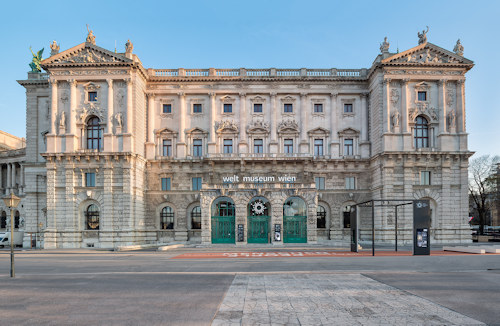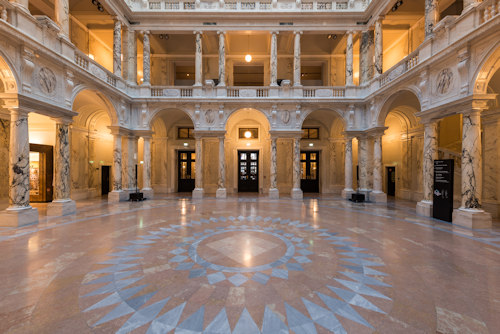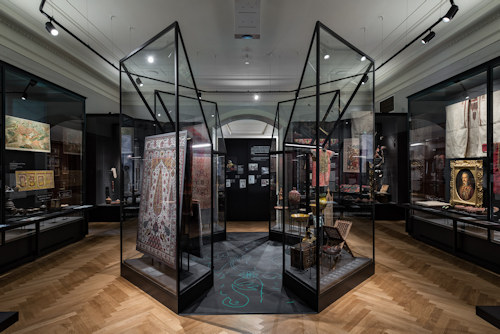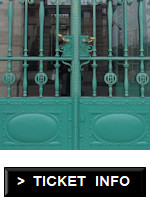The name Weltmuseum translates literally as “World museum”. Consider it a lucky dip into the history and culture of the world’s peoples…but with enough self-awareness to know issues are raised when you display valuable ethnic artifacts from other countries.
- Modern ethnographic museum
- Each room covers a region or sociocultural issue
- Also explores a theme’s relationship to Austria
- All info presented in English, too
- Ticket also gets you into:
- The imperial armoury
- Historical instrument collection
- Selected current special exhibitions:
- Book Weltmuseum tickets* online
- See also:
- Selected past Weltmuseum exhibitions
- Exhibitions in Vienna
- The Austrian museum of Folk Life and Folk Art
What’s the Weltmuseum?

(The Weltmuseum Wien; press photo © KHM-Museumsverband)
The permanent exhibitions of the Weltmuseum take you on a journey across the world, where each room tackles a particular topic or region.
One room might feature “Mesoamerica” with an ancient feathered Aztec headdress and “Day of the Dead” art; the next might examine the topic of “migration”.
As such, you experience a series of vignettes of world history and world cultures, often presented within the context of their connection to Austria.
So, as well as seeing 19th century Indian art, for example, you learn how the heir to Austria-Hungary, Franz Ferdinand, actually came to possess it.

(The gorgeous Hall of Columns; press photo © KHM-Museumsverband)
The museum occupies rooms in the Neue Burg part of the Hofburg Palace, encircling a huge marbled atrium known as the Hall of Columns (pictured above).
This entrance hall reminds me of a multilayered Roman villa, all cream marble columns flecked in black, and topped off by painted ceiling arches and a giant skylight. A most impressive sight.
Fresh and modern presentations, plenty of videos and interactive screens, and a diverse approach to displays gives each room its own character.
The overall result is a history museum. And a cultural museum. And a science museum. And, well, a museum of people, essentially.
The exhibits certainly mirror the variety and diversity in human cultures: a collection of Indonesian ankle chains in one room, an analysis of language distribution in modern-day Vienna in another.
Here a beautiful model of the Edo-period residence of a Japanese feudal lord, there a feather bust of a god from Hawaii.
In presenting these cultural and historical artifacts from a region, the Weltmuseum does not shy away from discussing the associated problems and complexities.
So displays of native American art include baseball caps that invite questions about cultural appropriation by sports teams. An examination of life in a Himalayan village highlights the migration of labour to other countries.

(Gallery “At the threshold of the Orient”; press photo © KHM-Museumsverband)
The museum raises such issues, but rarely resolves them. Instead, it encourages you to critically examine topics for yourself.
Nor does the Weltmuseum ignore the twin “elephants in the room” when it comes to ethnographic collections: colonialism and imperialism. (Three if you include the controversial Penacho.)
Austria never had the colonial legacy of, for example, a UK or France, but the Habsburgs were beneficiaries and enablers of colonial and imperialistic behaviour.
Ironically (and possibly deliberately?), a room examining the legitimacy of former colonial powers possessing valuable artifacts from abroad stands adjacent to one with a precious royal screen “liberated” by Austrian forces during the Chinese Boxer rebellion.
Tickets & visitor tips
As a national museum, kids under 19 go in free. A ticket from or for the Weltmuseum also includes any special exhibitions within.
(Booking service provided by Tiqets.com*, who I am an affiliate of)
The floor above the Weltmuseum permanent exhibitions houses two impressive collections included in the entrance ticket.
- The Imperial Armoury: an assortment of decorated arms and armour of the past that includes many spectacular items owned and worn by members of the nobility
- The Historical Musical Instruments collection: this presents the development of instruments through time but also features specific items used by Vienna’s famous composers
Look also for special exhibitions, particularly major exhibitions on the ground floor. These typically encompass ethnographic topics, but often layered in contemporary art.
A café and bistro occupies part of the Hall of Columns, so you can marvel at the architecture while you eat.
On my last visit, the bistro offered coffees, teas, cold drinks and cakes, but also snacks and meals, with both traditional Austrian fare, such as the Sacher variation on Frankfurter sausages, and one or two representatives of world cuisine, such as coconut curry.
A few more tips:
- You can normally visit the Hall of Columns and café (and the toilets, for example) without an entrance ticket
- The museum shop at the exit sells books, souvenirs etc. with a little more colour and diversity than the usual museum outlets. It shares premises with the Imperial Shop, which stocks Viennese wares, souvenirs, arts, and crafts of a more local nature
- All text, videos and interactive displays in the Weltmuseum part are in both German and English (nice!)
- Use a Vienna Pass (see my review) to get in once for free
- The location also offers the option to rent a special “House of Habsburg” audio guide that uses the Neue Burg and museum rooms to wander through the history of the dynasty that ruled Vienna and an empire for centuries
How to get to the Weltmuseum
It’s hard to miss the entrance. Face the huge, curved historical building on Heldenplatz square and the Weltmuseum sits at the right-hand end.
Finding Heldenplatz is easy. It’s at the core of the walking route you probably take on any visit to Vienna, part of the Hofburg complex, and opposite the imposing and popular Kunsthistorisches and Naturhistorisches museums.
Subway: The nearest station is Museumsquartier on the U2 line, but it’s just a short walk from Volkstheater (U2 and U3 lines), Herrengasse (U3) and even Karlsplatz (U1, U2 and U4), too.
Tram/bus: Take a 1, 2, 71 or D tram to Burgring
Address: Heldenplatz, 1010 Vienna | Website
